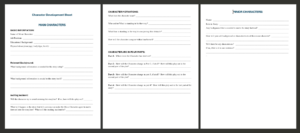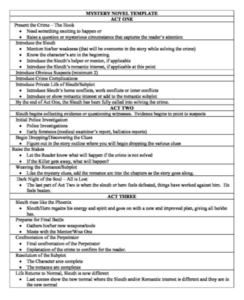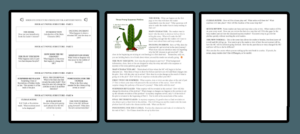MYSTERY NOVEL BRAINSTORMING WORKSHEET
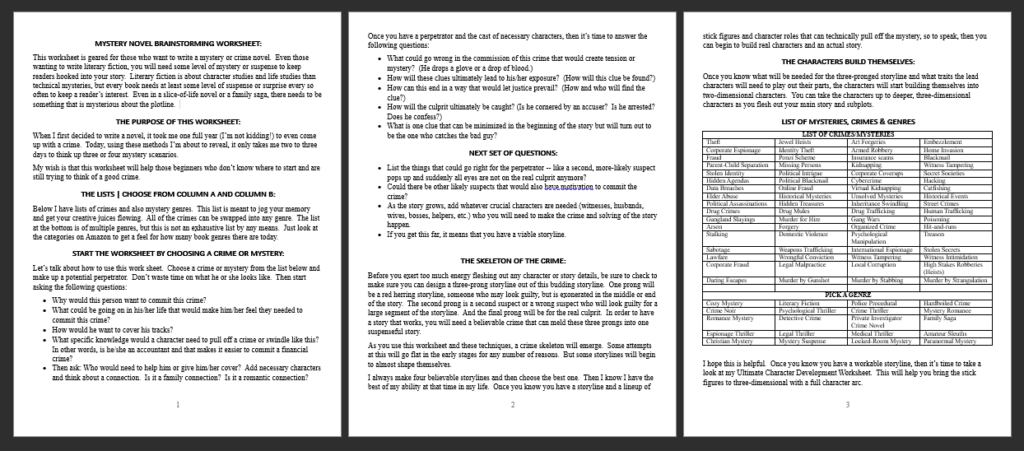
This worksheet is geared for those who want to write a mystery or crime novel. Even those wanting to write literary fiction, you will need some level of mystery or suspense to keep readers hooked into your story. Literary fiction is about character studies and life studies than technical mysteries, but every book needs at least some level of suspense or surprise every so often to keep a reader’s interest. Even in a slice-of-life novel or a family saga, there needs to be something that is mysterious about the plotline.
THE PURPOSE OF THIS WORKSHEET:
 When I first decided to write a novel, it took me one full year (I’m not kidding!) to even come up with a crime. Today, using these methods I’m about to reveal, it only takes me two to three days to think up three or four mystery scenarios.
When I first decided to write a novel, it took me one full year (I’m not kidding!) to even come up with a crime. Today, using these methods I’m about to reveal, it only takes me two to three days to think up three or four mystery scenarios.
My wish is that this worksheet will help those beginners who don’t know where to start and are still trying to think of a good crime.
THE LISTS | CHOOSE FROM COLUMN A AND COLUMN B:
Below I have lists of crimes and also mystery genres. This list is meant to jog your memory and get your creative juices flowing. All of the crimes can be swapped into any genre. The list at the bottom is of multiple genres, but this is not an exhaustive list by any means. Just look at the categories on Amazon to get a feel for how many book genres there are today.
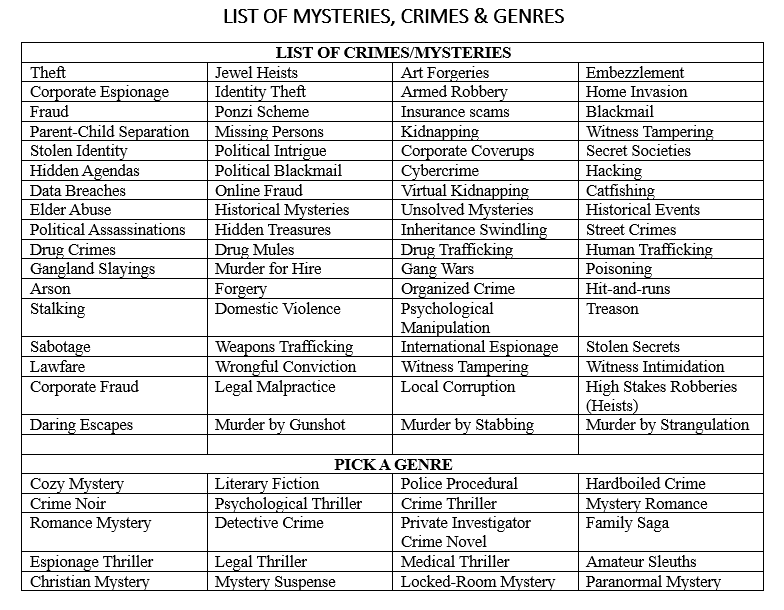
START THE WORKSHEET BY CHOOSING A CRIME OR MYSTERY:
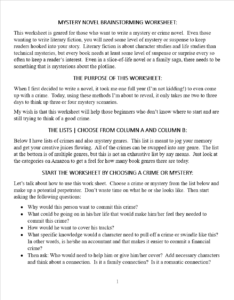 Let’s talk about how to use this work sheet. Choose a crime or mystery from the list below and make up a potential perpetrator. Don’t waste time on what he or she looks like. Then start asking the following questions:
Let’s talk about how to use this work sheet. Choose a crime or mystery from the list below and make up a potential perpetrator. Don’t waste time on what he or she looks like. Then start asking the following questions:
- Why would this person want to commit this crime?
- What could be going on in his/her life that would make him/her feel they needed to commit this crime?
- How would he want to cover his tracks?
- What specific knowledge would a character need to pull off a crime or swindle like this? In other words, is he/she an accountant and that makes it easier to commit a financial crime?
- Then ask: Who would need to help him or give him/her cover? Add necessary characters and think about a connection. Is it a family connection? Is it a romantic connection?
THE NEXT SET OF QUESTIONS TO ASK:
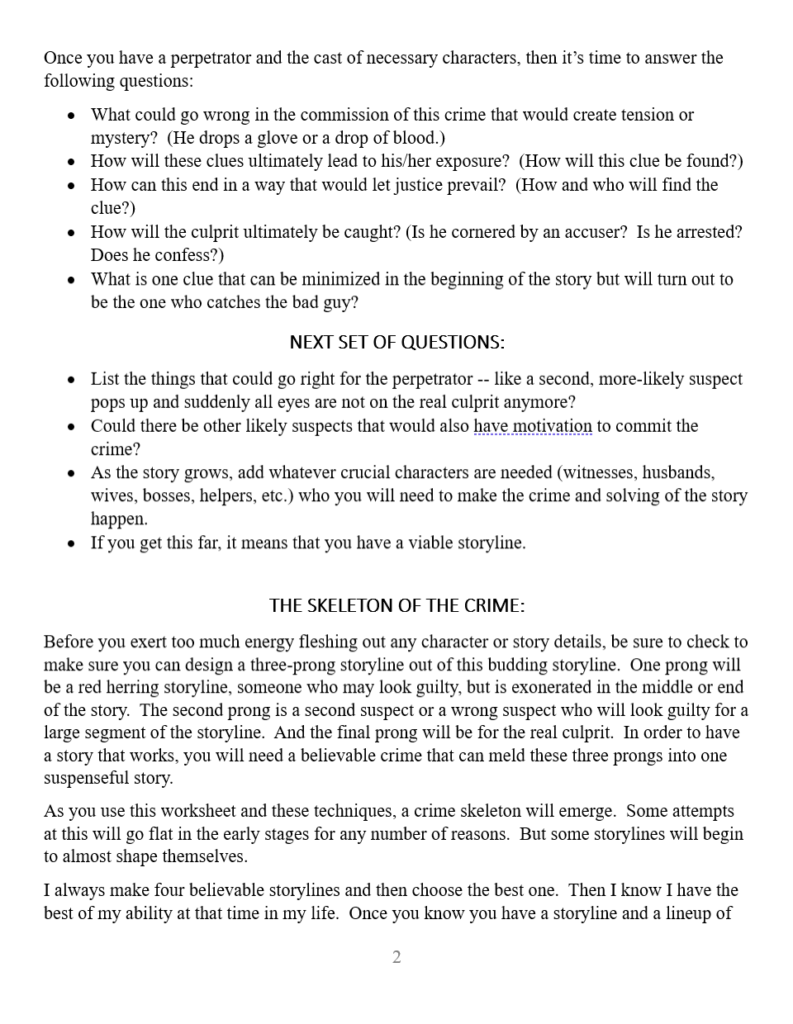 Once you have a perpetrator and the cast of necessary characters, then it’s time to answer the following questions:
Once you have a perpetrator and the cast of necessary characters, then it’s time to answer the following questions:
- What could go wrong in the commission of this crime that would create tension or mystery? (He drops a glove or a drop of blood.)
- How will these clues ultimately lead to his/her exposure? (How will this clue be found?)
- How can this end in a way that would let justice prevail? (How and who will find the clue?)
- How will the culprit ultimately be caught? (Is he cornered by an accuser? Is he arrested? Does he confess?)
- What is one clue that can be minimized in the beginning of the story but will turn out to be the one who catches the bad guy?
NEXT SET OF QUESTIONS:
- List the things that could go right for the perpetrator — like a second, more-likely suspect pops up and suddenly all eyes are not on the real culprit anymore?
- Could there be other likely suspects that would also have motivation to commit the crime?
- As the story grows, add whatever crucial characters are needed (witnesses, husbands, wives, bosses, helpers, etc.) who you will need to make the crime and solving of the story happen.
- If you get this far, it means that you have a viable storyline.
THE SKELETON OF THE CRIME:
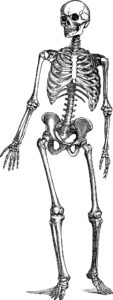 Before you exert too much energy fleshing out any character or story details, be sure to check to make sure you can design a three-prong storyline out of this budding storyline. One prong will be a red herring storyline, someone who may look guilty, but is exonerated in the middle or end of the story. The second prong is a second suspect or a wrong suspect who will look guilty for a large segment of the storyline. And the final prong will be for the real culprit. In order to have a story that works, you will need a believable crime that can meld these three prongs into one suspenseful story.
Before you exert too much energy fleshing out any character or story details, be sure to check to make sure you can design a three-prong storyline out of this budding storyline. One prong will be a red herring storyline, someone who may look guilty, but is exonerated in the middle or end of the story. The second prong is a second suspect or a wrong suspect who will look guilty for a large segment of the storyline. And the final prong will be for the real culprit. In order to have a story that works, you will need a believable crime that can meld these three prongs into one suspenseful story.
 As you use this worksheet and these techniques, a crime skeleton will emerge. Some attempts at this will go flat in the early stages for any number of reasons. But some storylines will begin to almost shape themselves.
As you use this worksheet and these techniques, a crime skeleton will emerge. Some attempts at this will go flat in the early stages for any number of reasons. But some storylines will begin to almost shape themselves.
I always make four believable storylines and then choose the best one. Then I know I have the best of my ability at that time in my life. Once you know you have a storyline and a lineup of stick figures and character roles that can technically pull off the mystery, so to speak, then you can begin to build real characters and an actual story.
THE CHARACTERS BUILD THEMSELVES:
Once you know what will be needed for the three-pronged storyline and what traits the lead characters will need to play out their parts, the characters will start building themselves into two-dimensional characters. You can take the characters up to deeper, three-dimensional characters as you flesh out your main story and subplots.
LIST OF MYSTERIES, CRIMES & GENRES
I hope this is helpful. Once you know you have a workable storyline, then it’s time to take a look at my Ultimate Character Development Worksheet. This will help you bring the stick figures to three-dimensional with a full character arc.


